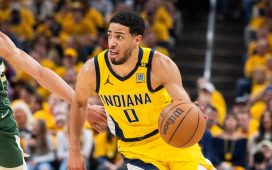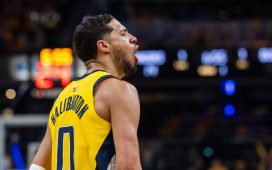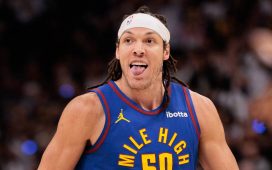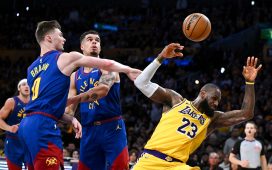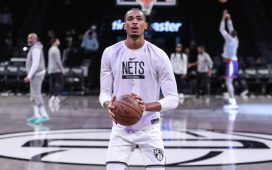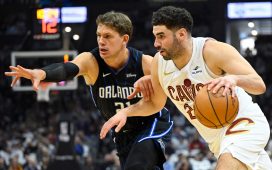As the Toronto Raptors’ season winds to a close, some particularly invested fans will look at the bottom of the NBA standings, and not just as a masochistic exercise. As a product of the Jakob Poeltl trade last year, the Raptors owe a top-six protected pick to the San Antonio Spurs in one of the next three seasons. The Raptors entered Tuesday’s play one loss behind the Memphis Grizzlies (expansion class of 1995, represent) for, you guessed it, the sixth-worst record.
The lottery could still shake up the draft standings, but every loss counts in terms of the odds of keeping the pick. However, there are reasons why the Raptors might want to give up that pick this year. Unless they have a top-six pick in each of the next three years (which isn’t the plan, although plans go awry sometimes), the Raptors will eventually send a pick to San Antonio. Is it better to do so now than in the future?
To answer that and other questions surrounding the Raptors and the 2024 NBA Draft, I asked The Athletic’s draft expert Sam Vecenie to answer some questions.
Koreen: Sam, thanks for making time for your friends in Canada. We’re both residents of the Commonwealth and therefore we must stick together.
Earlier in the year, I asked you about the Raptors’ top six-protected pick. I wanted to know whether or not the team should be hoping to give up its pick this year, when the draft is thought to be weak, or not. You said that you thought giving up the pick this year was ideal, and trying to win as many games with Pascal Siakam and OG Anunoby before the trade deadline before ultimately dealing them was optimal.
That ship has sailed. Toronto should finish with a record that has it either sixth or seventh in the reverse standings. In both scenarios, the Raptors would be more likely than not to fall outside the top six in the lottery (a 54.1 percent chance if they’re sixth versus a 68 percent chance if they’re seventh, assuming no ties). That means the terms of the question have changed.
Should the Raptors be hoping for lottery luck in May? What would the sixth pick in this draft be equivalent to in a “normal” draft?
Vecenie: Honestly, given the returns on those deals, I go back and forth on it. At the time we had that conversation, I didn’t expect them to go down the road of essentially a player swap for Anunoby, where all of the value came from players in RJ Barrett and Immanuel Quickley who are either already or about to be exceedingly expensive. It’s aggressive to call it a “creative” move, but it’s a style of trade that doesn’t happen often when guys like Anunoby in the final year of their contracts hit the market.
I liked the deal for Toronto at the time, and it’s only grown in my estimation for it. Barrett has been terrific for the Raptors and Quickley has been quite good since the calendar turned to February. But because they went down the road of acquiring players, it puts them on the clock in terms of building around Scottie Barnes. The clock isn’t speeding, but it’s ticking along in a way that the organization must be cognizant of as it plans its next leap up the standings. Barrett only has three years left on his deal. Quickley and the Raptors will likely have an interesting negotiation over the next few months, and if I were him, I’d want to do a four-year deal with a player option (something the Raptors have generally been willing to give out in their recent history).
It probably makes more sense for their timeline to have the asset in hand now instead of waiting for another year. For most other teams, I would think the other way. The 2024 NBA Draft is exceedingly questionable in terms of upside at the top, and the 2025 NBA Draft figures to be much stronger. But there will still be good players who will be selected this year. The sooner the Raptors can get a guy into their system and start working with him, the more likely that player is to contribute during a timeline that is more commensurate with the window Toronto seems to be building toward. Or, the team could keep the pick this year, and potentially even look to use it as a trade chip to get another player that fits the little 22- to 25-year-old group of talent it has on its roster.
Koreen: That makes a lot of sense. The combination of the Poeltl trade (ultimately unwise) and the Anunoby trade (trending positively) has put them in a unique position in the league.
On a related note: Do you have a sense of how deep/good the 2025 and 2026 drafts project to be? It is absurdly early to think along these lines, but with the Raptors’ pick carrying protections through 2026, it is relevant.
Vecenie: The 2025 and 2026 classes are seen as drastically better drafts at the top than the 2024 draft. Those classes will unlikely be seen as worse than the 2024 NBA Draft in terms of pick-by-pick value. The top of the 2025 class, particularly, is seen as very strong, with Cooper Flagg, Ace Bailey and Khaman Maluach. There is also thought to be a solid amount of depth for young talent in those classes.
Having said that, this is more about the 2024 draft being a serious question mark at the top. I’m not stingy with Tier 1 or Tier 2 grades (I’ve given out nine of them in the last two draft classes), and I don’t currently have a single player in 2024 who has one of those grades. Undeniably, players will be taken that will break through and develop into strong NBA players. Nobody questions that. Having said that, a draft’s strength is all about how possible it is to identify those players ahead of time. Some front offices do it better than others. But having a real depth of talented options is critical to assessing a draft’s overall strength, because there is a real information gap even for the most diligent front offices in how teenagers will develop.
Oklahoma City in 2022 is a great example. With back-to-back picks, the Thunder took Ousmane Dieng and Jalen Williams. They had a higher grade on Williams, but presumably, they thought they were at least in the same ballpark as players. A front office that does a great job of garnering intel and evaluating players took two players in the same draft, literally with two straight picks, and one looks like the biggest hit from that draft class based on draft position, and the other looks like a total miss at this point.
You’re never going to hit on every draft pick. It doesn’t happen. That means teams like having multiple options available that they’re comfortable with selecting when draft night comes. And right now, comparing this draft to the 2023 draft, I would have had seven players in 2023 ahead of even the top player on my board in 2024.
Koreen: Interesting. If nothing else, having a pick in 2024 would allow the Raptors to regain some of their lost lustre when it comes to identifying and developing talent.
In addition to maybe having their own pick, the Raptors also have the Indiana Pacers’ first-rounder as well as the Detroit Pistons’ second-rounder. When I think of bad drafts, I think of 2013. That draft still produced 22 players who logged at least 400 games in their careers, which suggests there were plenty of solid contributors in the group, beyond teams simply giving their picks too much rope to prove themselves. Do you see this class similarly or is it weak in the middle as well as at the top?
Vecenie: It’s funny you bring up 2013, because that’s the exact class that NBA executives and scouts bring up when I speak with them about the class. I don’t know that a Giannis Antetokounmpo is sticking out in terms of a high-upside swing that teams were scrambling for six months to gain information about — I don’t know if something like that can ever happen again in this age of information and data — but there are some interesting swings and could be a bit of depth.
Right around the 20-to-25 player mark is expected for legitimate players who emerge from each NBA Draft class. Sometimes it’s fewer, sometimes it’s more. I would anticipate the 2024 NBA Draft being similar for role players, as there are some interesting older players I have a degree of faith in. The numbers say that’s a reasonable bet.
We live in a new landscape of college basketball and draft declarations. The implementation of NIL rights for players has a chance to decimate the depth of this draft class a bit. Because you can make significant money playing in college now, there is no reason to take a risk on your professional future if your draft status isn’t assured. Of course, someone will still make a poor decision, but the fact we’re near the start of that process now could result in several players deciding to transfer or return to the school they’re at now and make a real payday. Then, they can go try their luck again next year.
Basically what I’m saying here is that I don’t feel comfortable at this stage assessing this draft’s depth. It might end up being quite good if several players unexpectedly turn pro. Or, it might end up being quite poor if some of the players on the fence decide to try their luck again next season. A lot remains up in the air there.
Koreen: If you haven’t been watching the Raptors closely — I don’t blame you — a funny thing has happened. After two years of having almost exclusively 6-foot-8 and 6-foot-9 players, suddenly they have one rotation player in that sweet spot: Barnes. (Barrett has good size, but is not a defensive force.)
It is a problem, especially defensively. Do you see any plus-defenders at that size who might be around in the middle of the first round who fill that need?

South Carolina’s Collin Murray-Boyles could be a name to watch for the Raptors. (Andy Lyons / Getty Images)
Vecenie: There are absolutely a few names worth knowing. The best defender in this draft class is Ryan Dunn from Virginia. He’s exactly what you’re after, a 6-foot-8 wing/forward who is, in my opinion, the best defender in college basketball. He’s elite as a help defender with timely rotations and scramble instincts. He’s disruptive with his hands and forces turnovers at an elite level. He’s strong and physical. He’s switchable athletically, capable of guarding one through five in college, and one through four in the NBA. The issue is he can’t do anything on offence. He’s not a great ballhandler and can’t shoot. He’s a sharp cutter and offensive rebounder but that’s it. If a team thinks they can figure out their spacing around him, I would go for it. He’s the best wing defender I’ve evaluated in a long time. For the Raptors, it would be tricky.
Bobi Klintman is another name worth tracking for the Raptors. He was with Cairns Taipans this year as an NBL Next Star in Australia. I wouldn’t say he’s an awesome defender, but he certainly has his moments on that end in scramble situations. He’s a good athlete for his size and has potential to knock down shots with a clean shooting stroke. He’ll be in this draft for sure, and makes sense for what you’re talking about.
One other name worth tracking would be Collin Murray-Boyles, a 6-foot-7 wing/forward that I would compare to someone like Grant Williams — except with a 7-foot-2 wingspan. He’s a monster defender as a freshman at South Carolina, and has been unbelievable to close the season for the Gamecocks, morphing into one of the most productive freshmen in the country over the last six weeks. He said last week he’s planning to return to South Carolina next season. However, if he has a big run in the NCAA Tournament, it could propel him to a different decision. You never know.
Koreen: You anticipated my next question. With that Pacers’ pick in mind (and the Pistons’ second-rounder, which would be No. 32 right now), are there any players that might be available in that 16-23 range, regardless of position, who you will be watching extra closely in the NCAA Tournament? Whether you are optimistic or pessimistic about their NBA potential, are there guys in that position for whom the next few weeks will be especially meaningful?
Vecenie: Murray-Boyles and Dunn are great names, for sure, that I’m tracking. That 16-to-23 range right now is extremely amorphous for teams. It’s hard to get a handle on where exactly they sit.
Kansas wing Johnny Furphy is another one of those 6-foot-9 wings who can play. He’s a tremendous athlete and a real shooter, and had a strong freshman season at Kansas. However, his close to the year has been a bit of a struggle, and he could use a couple of bounce-back tournament games. Duke guard Jared McCain has been one of the best scorers in the country as a freshman, and could use a strong tournament to push himself higher. Baylor big man Yves Missi has all the tools you could want for a low-usage center, but he’s a player who is still pretty raw and could use this tournament to propel himself to a different level.
I love watching Tyler Kolek and Oso Ighodaro for Marquette, and their range probably starts right around No. 20. They’re a terrific pick-and-roll tandem, with Kolek running the point at a high-level as a dribble-pass-shoot weapon, and Ighodaro as the best passer and distributor among bigs in the country. They’re both seniors. I also wonder if a few of the veteran college players could push themselves into that range, such as Creighton’s Trey Alexander and Baylor Scheierman, Colorado’s Tristan da Silva and Connecticut’s Alex Karaban. This is a weird year, because many of the prospects that teams are excited about will not be participating in the Big Dance.
Koreen: I can’t let you leave without giving your official opinion on Zach Edey, Toronto’s favourite very large son. Assuming he enters the draft, what do you think his realistic range is? From what you’ve seen, does he have a path to being a rotation player?
Vecenie: Yeah, I like Edey quite a bit, and think his range probably starts in the No. 18 or so area and extends into the early portion of the second round. He’ll likely be taken in the first somewhere. He’s just one of those people that I refuse to bet against. He’s all sorts of tough and has showcased real improvement every year he’s been in college.
Edey knows who he is. He sets killer screens, establishes position on the block, and goes to work to try to score. He crushes the offensive glass. He has good fundamentals for his size and warps the court due to how much space he takes up. He can shoot a little bit out beyond the 3-point line but refuses to do so because he thinks it’s not an efficient use of his skill set in college. Truly, I think that when he gets to the NBA, there’s a chance he develops some occasional pick-and-pop skills in the same way Jonas Valančiūnas has over the years.
Where you have Edey is all about the defense. He’s drastically improved as a drop coverage defender for the college game, but it remains to be seen if he has enough foot speed to manage in the NBA beyond being a situational player. The driving lanes in the NBA are wider. The shooting is better, giving players more space. He’ll be forced into positions in the pros that he hasn’t been previously in college. How he adjusts — and how capable he is of getting up and down the court without creating a transition disadvantage — will play the biggest roles in his future.
I have Edey in the mid-20s on my board personally. I buy the physicality and toughness. He can establish position on nearly any human being on the planet, even those at the highest level. That means something, even in the pace-and-space-centric NBA. He certainly has a chance to be a real rotation player, and I do think he’ll play in the NBA for a while at least as a situational guy because of those skills.
Koreen: Congratulations, Sam: We will let you across the border next time you fly into Pearson.
(Top photo of Virginia’s Ryan Dunn: Ryan M. Kelly / Getty Images)
